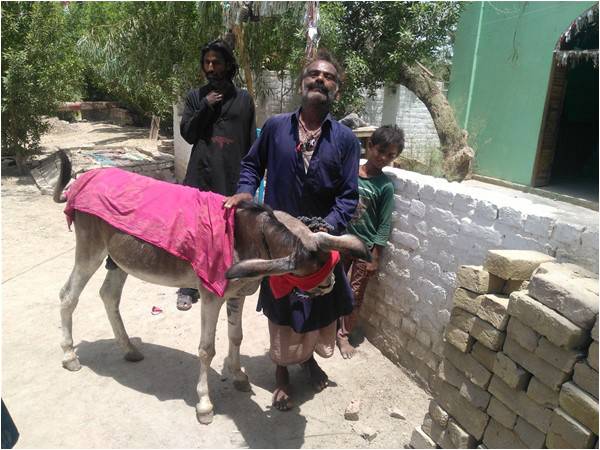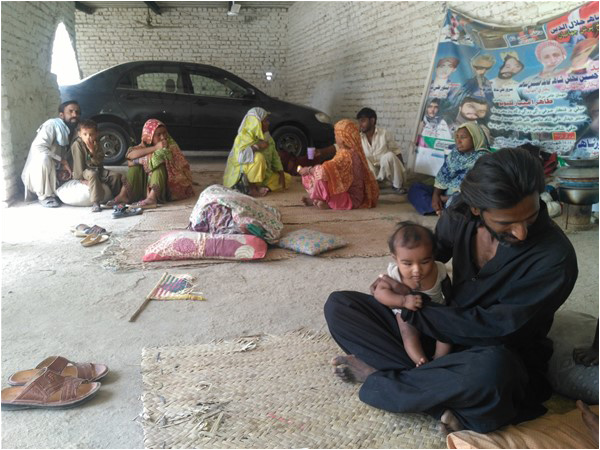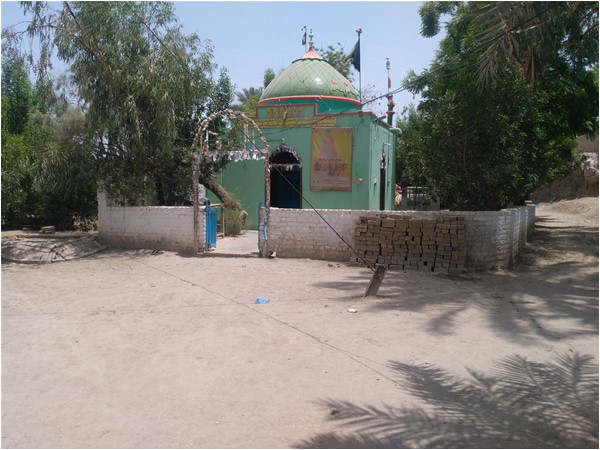
In Sukkur, as in many other parts of Pakistan, people usually throng the shrines to pay homage to the saints, offer prayers, and ask for certain mannats (wishes) to be granted. And when their mannat is fulfilled, they revisit the mazar (shrine) and lay floral wreaths or chaddars and distribute food or sweets amongst the devotees, according to their affordability.
Considering this pattern, the shrine of Makhdoom Pir Syed Rajan Qattaar Jahania, most popularly known as “Rajan Mast” situated at the bordering area of Sukkur and Khairpur districts some 15 kilometres away from Sukkur in Babarloi town, is a definite anomaly. In a unique twist, people are required to offer a donkey for their mannats to appease the entombed saint!
The colourful shrine, in Babarloi town, is a popular destination for devotees from across the country. According to Syed Atif Shah Jahania, the caretaker of the shrine, Makhdoom Pir Syed Rajan Qattaar Jahania belonged to the Makhdoom Jahania family of Uch Sharif and had migrated to Sindh more than 150 years ago. Rajan Mast’s great-grandfather’s shrine is in Uch Sharif, whilst his grandfather Syed Ali Sarmast is buried near the tomb of Qalandar Lal Shahbaz in Sehwan Sharif.

“People from far-flung areas of Balochistan, Punjab, Sindh and even Azad Kashmir come to pay homage to the saint”, says Atif Jahania. “Thousands of devotees converge at the shrine on the eve of the annual Urs, held on the 14th, 15th and 16th of Shaban,” the caretaker continues. “The saint loved to ride donkeys. Therefore, offering one in return for a granted mannat is deemed necessary” he explains. Syed Atif adds that alongside offering donkeys, people also lay floral wreaths, chaddars and distribute food.
According to Syed Atif, all the money collected from the sale of these donkeys is spent on the upkeep of the shrine because the authorities concerned do not pay heed towards its maintenance.
“We keep all these donkeys at the shrine, and devotees never forget to bring fodder for them,” he says. “We don’t fix prices for them. Instead, people pay according to their purchasing power!”
Also, interestingly, these donkeys become ‘special’ after being offered at the shrine. “People rush to the mazar to buy them,” Syed Atif says. People with all sorts of problems, mostly health related issues, come to the mazar. “The ill get well, and the childless are blessed with offspring,” claims the caretaker, adding that the sick are often required to stay at the dargah for four nights, during which they are treated by the saint. “Similarly, if a woman who desires a child stays at the shrine for seven Mondays, her wish will come true,” explains Syed Atif. “The child is born with a black spot on his or her body, which is covered with donkey hair”, he further says. The devotees, countless in number, talk of miracles. Their stories are all full of a firm belief in the saint.
One of the devotees, Mai Naseeba, who along with her ailing daughter Reema and other family members had come from Karachi, when asked why she didn’t go to the hospital in Karachi, replies, “We are poor people and therefore could not afford costly medicines prescribed by the doctors. Some of the people back in Karachi told me about the Dargah of Rajan Mast and I am here for last four days!” Her daughter Reema is 16 years old and suffered a paralysis-inducing stroke, which affected her right leg and arm. “We are here for last four days and my daughter has already started walking, though not properly”, she says, adding that she limps a little.

Another devotee Fakir Mohammad is a resident of Sukkur and has brought his wife, who according to him, was influenced by some supernatural power, due to which she was not able to talk any more. “Today is our third day at the dargah and she has already started talking!” he declares. “After spending another day at the dargah, we will leave for Sukkur on Tuesday.”
Mai Azizan another resident of Karachi had come to the dargah two days ago and was suffering from kidney stones. “The kidney pain was killing me,” she says, “But after my arrival at the dargah, I am feeling better. I hope that Rajan Mast will take good care of me and I will be perfectly alright.” she says.
Ali Akbar Jatoi, yet another devotee from Jacobabad, is a regular visitor of the dargah and this time he is here to get rid of a persistent fever. “I often visit the dargah, stay here and drink water from the earthen pots and get well”, he says with great confidence.
Ghulam Mustafa permanently resides at the dargah, because he has nowhere to live otherwise. “I am living here since my childhood and serve the devotees, besides cleaning and sweeping the dargah and its courtyard”, he says. “Saen Badshah (Rajan Mast) loved donkeys so much that he always used the animal to travel” Ghulam Mustafa relates. “But he always used to face the donkey’s tail instead of his head.” According to him, many childless couples have been blessed with children due to the intercession of Rajan Mast. And the children which are born due to his dua have a patch of donkey hair on their bodies, I am told. One of the Syed families of Babarloi was blessed with a baby boy, who had patch of donkey hair near his groin, while a girl had similar patch on her lower back: such are the claims.
This writer had the opportunity for interaction with some of the residents of Babarloi town, who narrated different stories about the saint. One of the shopkeepers requesting anonymity told me that one hundred years back, people mostly used donkeys, horses or camels for travelling and therefore there is nothing special about the saint riding or loving donkeys. “I see it as a business, because once the donkey is offered to the dargah, it becomes special and priceless”, he says. “And the people pay any amount to purchase such donkeys. I was born in this town and have turned 55, but have never seen a boy or girl with patches of donkey hair on their bodies!” he says.
On the contrary, some other residents firmly believe in saint’s blessings and healing powers. “If there was nothing good here, then what is the use of people visiting the dargah from all across the country?” they ask. “We have seen people with broken limbs, who are brought to the dargah and they leave walking on their own feet!” they confidently claim.
Considering this pattern, the shrine of Makhdoom Pir Syed Rajan Qattaar Jahania, most popularly known as “Rajan Mast” situated at the bordering area of Sukkur and Khairpur districts some 15 kilometres away from Sukkur in Babarloi town, is a definite anomaly. In a unique twist, people are required to offer a donkey for their mannats to appease the entombed saint!
The colourful shrine, in Babarloi town, is a popular destination for devotees from across the country. According to Syed Atif Shah Jahania, the caretaker of the shrine, Makhdoom Pir Syed Rajan Qattaar Jahania belonged to the Makhdoom Jahania family of Uch Sharif and had migrated to Sindh more than 150 years ago. Rajan Mast’s great-grandfather’s shrine is in Uch Sharif, whilst his grandfather Syed Ali Sarmast is buried near the tomb of Qalandar Lal Shahbaz in Sehwan Sharif.

“People from far-flung areas of Balochistan, Punjab, Sindh and even Azad Kashmir come to pay homage to the saint”, says Atif Jahania. “Thousands of devotees converge at the shrine on the eve of the annual Urs, held on the 14th, 15th and 16th of Shaban,” the caretaker continues. “The saint loved to ride donkeys. Therefore, offering one in return for a granted mannat is deemed necessary” he explains. Syed Atif adds that alongside offering donkeys, people also lay floral wreaths, chaddars and distribute food.
According to Syed Atif, all the money collected from the sale of these donkeys is spent on the upkeep of the shrine because the authorities concerned do not pay heed towards its maintenance.
“We keep all these donkeys at the shrine, and devotees never forget to bring fodder for them,” he says. “We don’t fix prices for them. Instead, people pay according to their purchasing power!”
One of the devotees, Mai Naseeba, explains "We are poor people and therefore could not afford costly medicines prescribed by the doctors"
Also, interestingly, these donkeys become ‘special’ after being offered at the shrine. “People rush to the mazar to buy them,” Syed Atif says. People with all sorts of problems, mostly health related issues, come to the mazar. “The ill get well, and the childless are blessed with offspring,” claims the caretaker, adding that the sick are often required to stay at the dargah for four nights, during which they are treated by the saint. “Similarly, if a woman who desires a child stays at the shrine for seven Mondays, her wish will come true,” explains Syed Atif. “The child is born with a black spot on his or her body, which is covered with donkey hair”, he further says. The devotees, countless in number, talk of miracles. Their stories are all full of a firm belief in the saint.
One of the devotees, Mai Naseeba, who along with her ailing daughter Reema and other family members had come from Karachi, when asked why she didn’t go to the hospital in Karachi, replies, “We are poor people and therefore could not afford costly medicines prescribed by the doctors. Some of the people back in Karachi told me about the Dargah of Rajan Mast and I am here for last four days!” Her daughter Reema is 16 years old and suffered a paralysis-inducing stroke, which affected her right leg and arm. “We are here for last four days and my daughter has already started walking, though not properly”, she says, adding that she limps a little.

Another devotee Fakir Mohammad is a resident of Sukkur and has brought his wife, who according to him, was influenced by some supernatural power, due to which she was not able to talk any more. “Today is our third day at the dargah and she has already started talking!” he declares. “After spending another day at the dargah, we will leave for Sukkur on Tuesday.”
Mai Azizan another resident of Karachi had come to the dargah two days ago and was suffering from kidney stones. “The kidney pain was killing me,” she says, “But after my arrival at the dargah, I am feeling better. I hope that Rajan Mast will take good care of me and I will be perfectly alright.” she says.
Ali Akbar Jatoi, yet another devotee from Jacobabad, is a regular visitor of the dargah and this time he is here to get rid of a persistent fever. “I often visit the dargah, stay here and drink water from the earthen pots and get well”, he says with great confidence.
Ghulam Mustafa permanently resides at the dargah, because he has nowhere to live otherwise. “I am living here since my childhood and serve the devotees, besides cleaning and sweeping the dargah and its courtyard”, he says. “Saen Badshah (Rajan Mast) loved donkeys so much that he always used the animal to travel” Ghulam Mustafa relates. “But he always used to face the donkey’s tail instead of his head.” According to him, many childless couples have been blessed with children due to the intercession of Rajan Mast. And the children which are born due to his dua have a patch of donkey hair on their bodies, I am told. One of the Syed families of Babarloi was blessed with a baby boy, who had patch of donkey hair near his groin, while a girl had similar patch on her lower back: such are the claims.
This writer had the opportunity for interaction with some of the residents of Babarloi town, who narrated different stories about the saint. One of the shopkeepers requesting anonymity told me that one hundred years back, people mostly used donkeys, horses or camels for travelling and therefore there is nothing special about the saint riding or loving donkeys. “I see it as a business, because once the donkey is offered to the dargah, it becomes special and priceless”, he says. “And the people pay any amount to purchase such donkeys. I was born in this town and have turned 55, but have never seen a boy or girl with patches of donkey hair on their bodies!” he says.
On the contrary, some other residents firmly believe in saint’s blessings and healing powers. “If there was nothing good here, then what is the use of people visiting the dargah from all across the country?” they ask. “We have seen people with broken limbs, who are brought to the dargah and they leave walking on their own feet!” they confidently claim.

